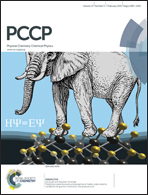Oxygen-participated electrochemistry of new lithium-rich layered oxides Li3MRuO5 (M = Mn, Fe)
Abstract
We describe the synthesis, crystal structure and lithium deinsertion–insertion electrochemistry of two new lithium-rich layered oxides, Li3MRuO5 (M = Mn, Fe), related to rock salt based Li2MnO3 and LiCoO2. The Li3MnRuO5 oxide adopts a structure related to Li2MnO3 (C2/m) where Li and (Li0.2Mn0.4Ru0.4) layers alternate along the c-axis, while the Li3FeRuO5 oxide adopts a near-perfect LiCoO2 (R![[3 with combining macron]](https://www.rsc.org/images/entities/char_0033_0304.gif) m) structure where Li and (Li0.2Fe0.4Ru0.4) layers are stacked alternately. Magnetic measurements indicate for Li3MnRuO5 the presence of Mn3+ and low spin configuration for Ru4+ where the itinerant electrons occupy a π*-band. The onset of a net maximum in the χ vs. T plot at 9.5 K and the negative value of the Weiss constant (θ) of −31.4 K indicate the presence of antiferromagnetic superexchange interactions according to different pathways. Lithium electrochemistry shows a similar behaviour for both oxides and related to the typical behaviour of Li-rich layered oxides where participation of oxide ions in the electrochemical processes is usually found. A long first charge process with capacities of 240 mA h g−1 (2.3 Li per f.u.) and 144 mA h g−1 (1.38 Li per f.u.) is observed for Li3MnRuO5 and Li3FeRuO5, respectively. An initial sloping region (OCV to ca. 4.1 V) is followed by a long plateau (ca. 4.3 V). Further discharge–charge cycling points to partial reversibility (ca. 160 mA h g−1 and 45 mA h g−1 for Mn and Fe, respectively). Nevertheless, just after a few cycles, cell failure is observed. X-ray photoelectron spectroscopy (XPS) characterisation of both pristine and electrochemically oxidized Li3MRuO5 reveals that in the Li3MnRuO5 oxide, Mn3+ and Ru4+ are partially oxidized to Mn4+ and Ru5+ in the sloping region at low voltage, while in the long plateau, O2− is also oxidized. Oxygen release likely occurs which may be the cause for failure of cells upon cycling. Interestingly, some other Li-rich layered oxides have been reported to cycle acceptably even with the participation of the O2− ligand in the reversible redox processes. In the Li3FeRuO5 oxide, the oxidation process appears to affect only Ru (4+ to 5+ in the sloping region) and O2− (plateau) while Fe seems to retain its 3+ state.
m) structure where Li and (Li0.2Fe0.4Ru0.4) layers are stacked alternately. Magnetic measurements indicate for Li3MnRuO5 the presence of Mn3+ and low spin configuration for Ru4+ where the itinerant electrons occupy a π*-band. The onset of a net maximum in the χ vs. T plot at 9.5 K and the negative value of the Weiss constant (θ) of −31.4 K indicate the presence of antiferromagnetic superexchange interactions according to different pathways. Lithium electrochemistry shows a similar behaviour for both oxides and related to the typical behaviour of Li-rich layered oxides where participation of oxide ions in the electrochemical processes is usually found. A long first charge process with capacities of 240 mA h g−1 (2.3 Li per f.u.) and 144 mA h g−1 (1.38 Li per f.u.) is observed for Li3MnRuO5 and Li3FeRuO5, respectively. An initial sloping region (OCV to ca. 4.1 V) is followed by a long plateau (ca. 4.3 V). Further discharge–charge cycling points to partial reversibility (ca. 160 mA h g−1 and 45 mA h g−1 for Mn and Fe, respectively). Nevertheless, just after a few cycles, cell failure is observed. X-ray photoelectron spectroscopy (XPS) characterisation of both pristine and electrochemically oxidized Li3MRuO5 reveals that in the Li3MnRuO5 oxide, Mn3+ and Ru4+ are partially oxidized to Mn4+ and Ru5+ in the sloping region at low voltage, while in the long plateau, O2− is also oxidized. Oxygen release likely occurs which may be the cause for failure of cells upon cycling. Interestingly, some other Li-rich layered oxides have been reported to cycle acceptably even with the participation of the O2− ligand in the reversible redox processes. In the Li3FeRuO5 oxide, the oxidation process appears to affect only Ru (4+ to 5+ in the sloping region) and O2− (plateau) while Fe seems to retain its 3+ state.


 Please wait while we load your content...
Please wait while we load your content...